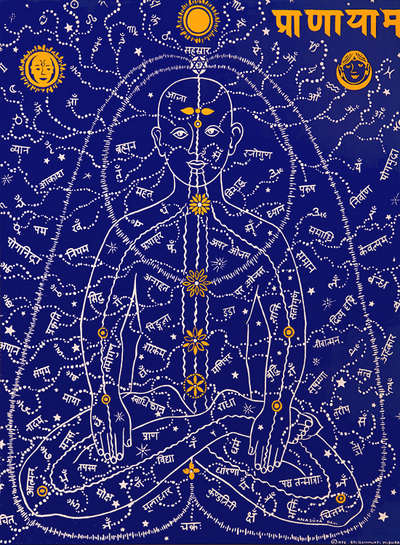The Power of Prana

Our last meeting of the Yoga Sutra Discussion group covered the Yoga Sutras devoted to Pranayama (the practice of breath regulation) – Chapter II, sutras 49-53. And, of course, the first thing to really look at is the definition of prana itself.
The first sutra that describes the practice of Pranayama says that it should only be practiced after the practice of asana has been perfected, but who has done that lately? No matter how perfect our Instgram photo might be, “perfection in asana” by the Yoga Sutra standard is “when the effort to perform it becomes effortless and the infinite being within is reached”, and also “when the practitioner is no longer disturbed by dualities”. If we go by the definition of prana as merely “breath” and Pranayama as just playing around with different “breath control”, then these sutras seem a little extreme.
But prana is NOT just “breath”. Whenever I teach Pranayama, I very typically read the 5 or so paragraphs spanning almost an entire page in BKS Iyengar’s translation of The Yoga Sutras of Patanjali that describe prana. To put it simply, prana is the actual energy of all life. It is the power and the vibration that runs through the entire Universe, and we connect to that power through our own breath. To harness that power takes stability in body and mind and a lack of disturbance to our senses when that power is manipulated – hence “perfection in asana”.
Obviously we do not wait until perfection in our body and mind occur to begin simple Pranayama practice, but it is necessary to have some postural practice behind you in order to have an ability to sit still or relax completely, to keep the mind steady for even a moment, and to have space in the body to accept and receive the breath physically.
Yoga Sutra II.50 states the technical definition of Pranayama as having 3 movements, and those movements being regulated according time and space.
The three movements highlight the connection of our breath to our consciousness and the ability for the breath to be powerful in its uniting our inner purusa (clear, unchanging consciousness) with our outer mind (ever changing and moving). The inhalation is the process of bringing the inner clear consciousness more to the surface, the exhalation is the surrender of the mental fluctuations to the clear consciousness within, and the pauses between are the third part of the breath that bring us closer to the experience of “pure being”.
When we regulate the breath we are dealing with time (length of breath, length of time in practice, length of each part of the breath, etc…) and space (where the breath moves, focus of the breath in certain areas, etc…).It makes more sense again to understand the true meaning of prana when looking at the “space” that can be touched. Pranayama does not just effect the physical breathing apparatus, but can percolate the energy of prana throughout our being using the energetic system of nadis and chakras (stay tuned for a future blog on these topics).
The real power of prana and Pranayama is to “remove the veil covering the light of knowledge and begins the dawn of wisdom” (Yoga Sutra II.52). When we can sit quietly, open ourselves to the power of prana, experience even small cracks in the clouds that cover the knowledge of our True Self, we literally begin to gain the ultimate wisdom of life. Our mind becomes more clear and steady and is able to stay present for the next practices of yoga, Pratyahara (drawing the senses in), and Dharana (concentration).
Join us for the next Yoga Sutra discussion group! We meet on the last Sundays of each month and each meeting stands alone in topic, along with recaps and review of previous topics.